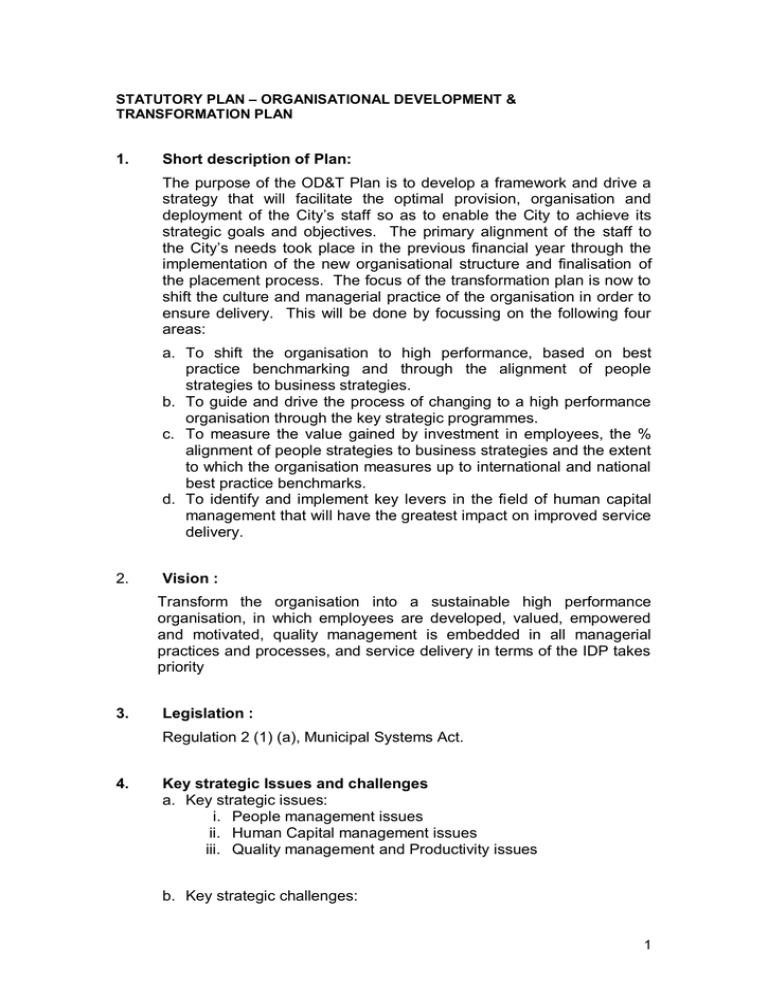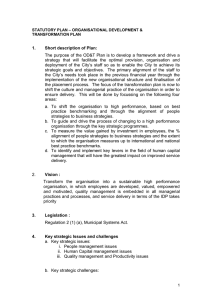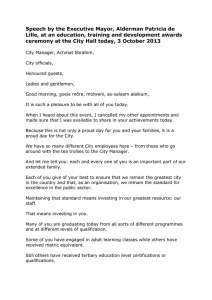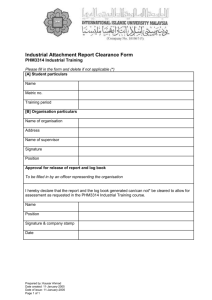1. Short description of Plan:
advertisement

STATUTORY PLAN – ORGANISATIONAL DEVELOPMENT & TRANSFORMATION PLAN 1. Short description of Plan: The purpose of the OD&T Plan is to develop a framework and drive a strategy that will facilitate the optimal provision, organisation and deployment of the City’s staff so as to enable the City to achieve its strategic goals and objectives. The primary alignment of the staff to the City’s needs took place in the previous financial year through the implementation of the new organisational structure and finalisation of the placement process. The focus of the transformation plan is now to shift the culture and managerial practice of the organisation in order to ensure delivery. This will be done by focussing on the following four areas: a. To shift the organisation to high performance, based on best practice benchmarking and through the alignment of people strategies to business strategies. b. To guide and drive the process of changing to a high performance organisation through the key strategic programmes. c. To measure the value gained by investment in employees, the % alignment of people strategies to business strategies and the extent to which the organisation measures up to international and national best practice benchmarks. d. To identify and implement key levers in the field of human capital management that will have the greatest impact on improved service delivery. 2. Vision : Transform the organisation into a sustainable high performance organisation, in which employees are developed, valued, empowered and motivated, quality management is embedded in all managerial practices and processes, and service delivery in terms of the IDP takes priority 3. Legislation : Regulation 2 (1) (a), Municipal Systems Act. 4. Key strategic Issues and challenges a. Key strategic issues: i. People management issues ii. Human Capital management issues iii. Quality management and Productivity issues b. Key strategic challenges: 1 i. Research & develop conceptual framework, methodologies and models which will empower the organisation to change its managerial practices and assess deliverables from citizen/customer/investor perspective. ii. Review current people management strategies. iii. Establish buy in from organisation to accept new ways of thinking and functioning. 5. Critical success factors: a. Leadership buy in to and ownership of transformation plan and framework. b. Creating change in climate and culture through change management interventions. c. Implementation of business management system (quality management system). 6. Strategies a. Embedding of high performance quality management systems and practices b. Ongoing strategising which focuses on a challenging desired future through the IDP process c. Development of business partners (internal & external) required to achieve desired destiny d. Development of transformational leaders e. Aligning people strategies to business strategies f. Releasing potential of people g. Broadbased change management initiative 7. Strategic Goals and Objectives a. Improving customer satisfaction (internal & external) b. Improving the operational efficiency of the organisation c. Improving return on investment in human capital d. The reduction in loss of critical talent e. Improving employee loyalty index rating 8. Key Deliverables a. Business improvement processes conducted for all core City wide business processes and other key functional areas impacting on Customer satisfaction b. Personal development plans for all employees c. Full SAP workflow functionality for all HR business processes d. Comprehensive leadership development programme e. Corporate wide individual performance management f. Full e-HR capacity 2 9. Resources to be used to achieve outcomes a. Capex : R9 million over three years b. Opex : R55 million over 3 years (inclusive of RG funding) 10. Key Strategic Programmes a. Human Capital Management Programme b. Change Management and Communication Plan c. Quality Management and Business Improvement Programme d. e-HR Programme 11. Key performance Indicators a. Customer Satisfaction: Directorates to achieve the target of a minimum X% increase in customer satisfaction with their services by 2011. b. Operational Efficiency shall be measured as: Responsivenessratio between CR Notifications created/number notifications closed Process efficiencyratio between created/number notifications closed CR Notifications Staff Cost or Cost saving? (alternatively a efficiency saving of X percent on all internal support services, which will be re-directed to direct service delivery operations) Staff productivity- measure still to be developed The objective will be to improve these measures by X % per year. c. Staff Loyalty- experiencing index. The objectives will be to achieve: % improvement in staff experiencing feelings of accomplishment index. % improvement in the management excellence rating index % increase in staff care and concern index % increase in staff fairness at work index 3








